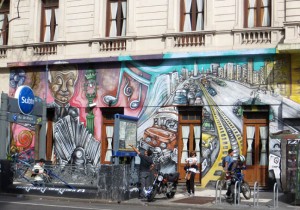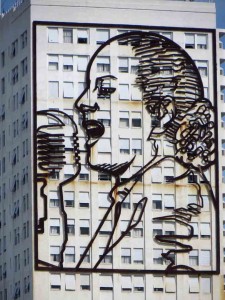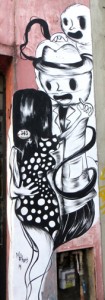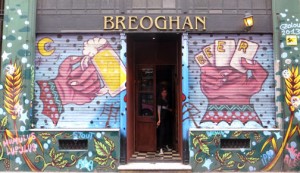 Buenos Aires is notable for its wall graffiti and subway art, but unless you’re in the San Telmo neighborhood or taking the subte, you may miss the best examples. Not so the street murals, which grace much of the city, in particular the Microcentro area in the heart of the city.
Buenos Aires is notable for its wall graffiti and subway art, but unless you’re in the San Telmo neighborhood or taking the subte, you may miss the best examples. Not so the street murals, which grace much of the city, in particular the Microcentro area in the heart of the city.
These murals are lovingly painted, and include iconographic Argentine figures. One of the most visible is the massive mural featuring Astor Piazzolla, the late king of the Nuevo Tango, whose mural takes up the entire first floor of a large building on the southeast corner of Avenida 9 Julio and Avenida de Mayo. Here, the concertinist is shown blissfully playing under a gas-lit street lamp, musical notes soaring over the traffic heading north on 9 de Julio, led by a school bus.
 Further south on 9 de Julio is a massive metal sculpture, figure of Evita Person with a microphone, twenty stories above the boulevard on a building’s north face. Nine stories tall, it takes up the entire width of the building.
Further south on 9 de Julio is a massive metal sculpture, figure of Evita Person with a microphone, twenty stories above the boulevard on a building’s north face. Nine stories tall, it takes up the entire width of the building.
 Murals are incorporated into storefronts, decorating rolling doors, or seemingly appearing out of nowhere, embellishing small spaces separating adjoining buildings. Commonly, their themes relate to drinking, dancing, and the tango. Their ubiquitous presence underscores Buenos Aires’ reputation as an art capital, and are constant delights to those seeking surprises where they may least expect to find them.
Murals are incorporated into storefronts, decorating rolling doors, or seemingly appearing out of nowhere, embellishing small spaces separating adjoining buildings. Commonly, their themes relate to drinking, dancing, and the tango. Their ubiquitous presence underscores Buenos Aires’ reputation as an art capital, and are constant delights to those seeking surprises where they may least expect to find them.
Leave a Reply